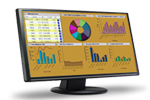Custom SaaS application development services have been in demand ever since it sprung up about a decade ago and has created quite a stir in the IT world. SaaS gives remote access to software Web-based services and allows different businesses to access applications at a low cost, lower than most of licensed applications because it’s a monthly fee subscription.
The software is remotely hosted so there is no need to invest in more hardware. Further, it eliminates the need for small businesses to have to deal with installation, set-up, daily upkeep and maintenance. For companies without any IT resources, this is certainly an attractive proposition.
Companies that offer SaaS also gain access to your computer systems other than hosting services in the user systems. So just how secure are the services?
The last thing anyone will want is that their data is in unwanted hands. It is hence essential that one makes it sure that the SaaS implementation vendor is one who can be reposed faith in, as well as reputed in the line of business. Customer references in great numbers are a must while making the choice. Some kind of track record of successful delivery should be traced for a new provider.
Another angle is customer support. Obviously, software and data security should be at the forefront in the list of SaaS service vendor selection criteria. Additionally, a vital part is how vendors keep their data secure and how doe they protect the data in times of disaster.
A good SaaS service vendor is expected to have many mirrored data centers where client data will be backed up and always available even in times of crisis.
SaaS service vendors use a variety of ways to secure client data. Some prefer a to have a collection of disks containing data protected with encryption. Some prefer the data locked up in large vaults especially in a remote location.
Article Source
http://www.articlecity.com/articles/web_design_and_development/article_1722.shtml
The software is remotely hosted so there is no need to invest in more hardware. Further, it eliminates the need for small businesses to have to deal with installation, set-up, daily upkeep and maintenance. For companies without any IT resources, this is certainly an attractive proposition.
Companies that offer SaaS also gain access to your computer systems other than hosting services in the user systems. So just how secure are the services?
The last thing anyone will want is that their data is in unwanted hands. It is hence essential that one makes it sure that the SaaS implementation vendor is one who can be reposed faith in, as well as reputed in the line of business. Customer references in great numbers are a must while making the choice. Some kind of track record of successful delivery should be traced for a new provider.
Another angle is customer support. Obviously, software and data security should be at the forefront in the list of SaaS service vendor selection criteria. Additionally, a vital part is how vendors keep their data secure and how doe they protect the data in times of disaster.
A good SaaS service vendor is expected to have many mirrored data centers where client data will be backed up and always available even in times of crisis.
SaaS service vendors use a variety of ways to secure client data. Some prefer a to have a collection of disks containing data protected with encryption. Some prefer the data locked up in large vaults especially in a remote location.
Article Source
http://www.articlecity.com/articles/web_design_and_development/article_1722.shtml

